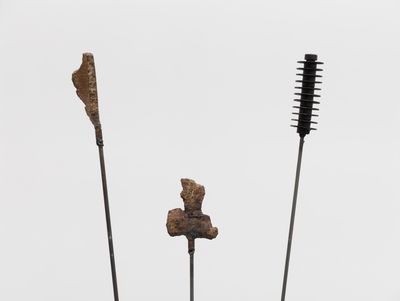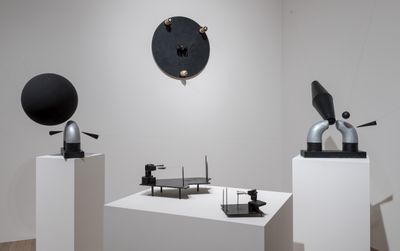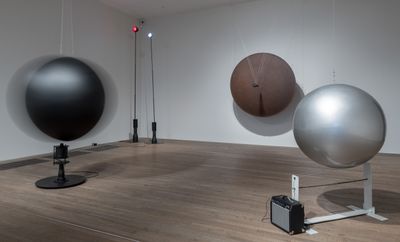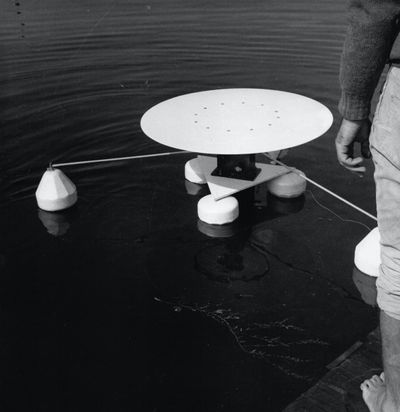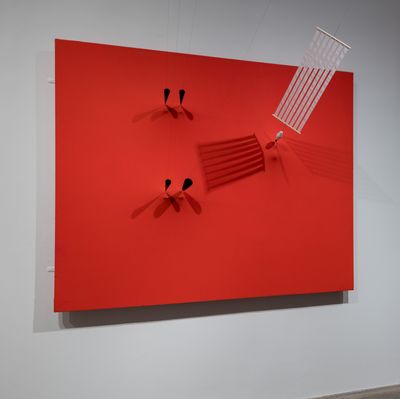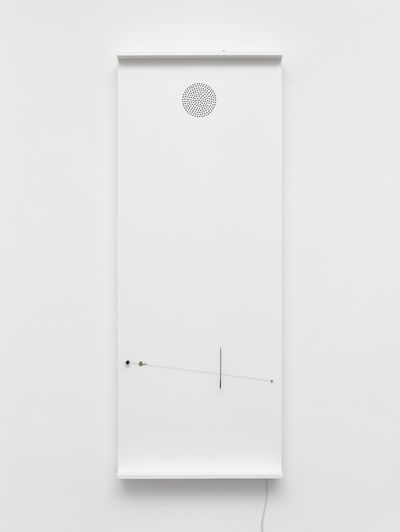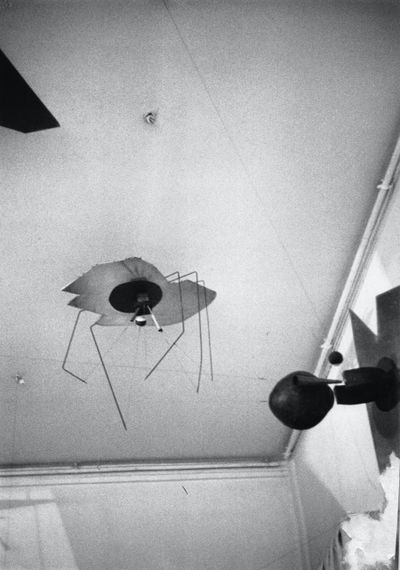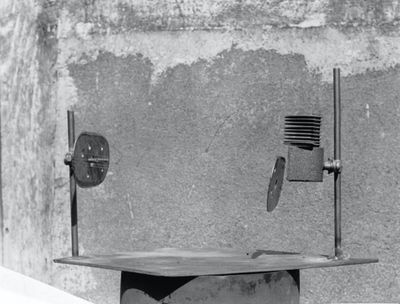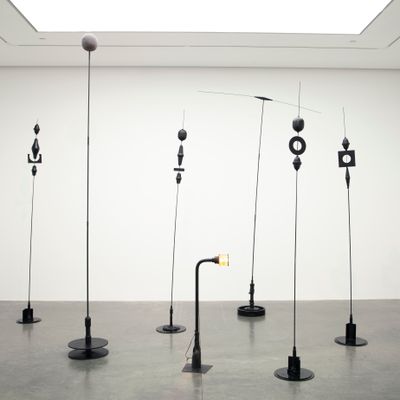Takis, the 'Instinctive Scientist'

Takis, Mur Magnetique (1970). Painted canvas, magnets, and iron elements. 175.5 x 335.5 x 50 cm (dimensions variable). © Takis Foundation. Courtesy White Cube. Photo: © White Cube (Theo Christelis).
'Signals', the most famous series by the late Greek artist Takis, is composed of thin pulsating metal rods carrying strange objects, like radio antennae, eyes, or rocks.
Inspired by the 'jungle of iron'1 the artist observed at Calais Station in Paris in 1955, and the signal technologies that caught his eye there, these sensual totemic sculptures respond to wind and vibration, sometimes making musical sounds in response, like conductors of invisible energies.
Self-taught, Takis described himself as an 'instinctive scientist', and his kinetic and acoustic art experiments starting from the late 1950s until his recent death in 2019 harnessed different forms of energy—mechanical, electromechanical, thermal, magnetic, hydrodynamic—to extend the limits of sculpture.
'Takis' kinetic and static works are great antidotes to our screen-based, digital world', notes White Cube director of external projects, Toby Kamps on the occasion of the artist's first exhibition in Asia at White Cube Hong Kong (21 November 2020–27 February 2021). 'They make the wonders of a usually invisible fourth dimension perceptible.'
Featuring sculptures drawn from the end of the 1960s to the 1990s, including a selection of 'Signals' works, the White Cube show follows the artist's impressive 2019 retrospective co-organised by Tate Modern, the MACBA Museu d'Art Contemporani de Barcelona, and the Museum of Cycladic Art in Athens.
Takis' poetic and captivating artistic journey could be seen as a lifelong pursuit to capture motion and make energy visible—even when still working with stone in the early 1950s in Athens. An admirer of ancient Greek art and Picasso and Giacometti, the artist was driven by a desire to transform material by working with it and thus understanding 'what happens in its interior'2—that is, to capture the life and the intelligence of the material, follow its rules, and contribute to 'the expression of its cosmic trend and thought'.3
The multiple Vibrating Vertical Line ECG – V.Si.245 (1966), involving an iron wire whose movement is propelled by a miniature electromagnet, opens the White Cube Hong Kong exhibition, and confirms what Takis said shortly before his death, in a video published by Tate Modern: 'I know how to use energy'.4
Made of bits and pieces found in army surplus stores, the sculpture exemplifies the artist's attraction to magnetism and the power of gravity, dating from the first 'Sculptures Télémagnétiques' that he created in 1959, the first of which is a nail suspended by a magnet in mid-air, to his research in MIT's Center for Advanced Visual Studies, where he gained a fellowship in 1968.
Focusing on liquid suspended due to electromagnetic forces, what emerged from the artist's time at MIT were his 'Sculptures Hydromagnétiques'. Sea Oscillation (1968), a device using sea waves to produce electricity, was inspired by Bicycle Wheel, the first readymade by Marcel Duchamp, who called Takis 'the happy ploughman of magnetic fields'.5
Takis' poetic and captivating artistic journey could be seen as a lifelong pursuit to capture motion and make energy visible...
Throughout his work, magnets and electromagnets enable objects to hover in the air, swinging or dancing, whether suspended from the ceiling by a wire or suspended over two-dimensional surfaces and magnetic blackboards.
The magnetising sounds produced by many of Takis' sculptures are a key element of his work, with his 'Sculptures Musicales' producing serene sounds using strings, magnets, and amplifiers, prompting The New Scientist magazine to declare Takis, Iannis Xenakis, and John Cage the most promising musicians of the century in 1966.6 In Musical (1966), a freestanding panel of wood is fixed with an electrical circuit, needle, and cord string to produce a form of 'raw music', which for Takis signified the sound of the cosmos.
The playful character of Takis' work demonstrates an instinctive approach towards harnessing natural phenomena into form. In 1960, he made his friend, the South African poet Sinclair Beiles, hover within a magnetic field to read his magnetic anti-nuclear manifesto 'The Impossible – Man in Space' at Iris Clert Gallery in Paris in 1962, only to fall to the ground after uttering the first sentence: 'I am a sculpture'.
But Takis experiments are not limited to the level of form alone. 'Lights, sounds, objects, installations or public events, question, at last, the very function of art in the social space and the universe, reimposing a sensational but also a philosophical dimension', he once said. An attitude that gestured towards a strong political sensitivity.7
The creation of numerous multiples pushed towards a certain democratisation of art, in a similar fashion to the numerous street happenings that he performed on squares across Paris in the late 1950s using fireworks.
He also described 'Signals', after which a legendary 1960s gallery for experimental art in London was named, as 'an essential hit on the function of the purchasable object' and 'aesthetic complacency', 'opening the road for joyful and unexpected revolution, somewhere between a childish explosion and a conscious inflammatory action.'8
Takis' notorious entrance at MoMA New York in January 1969 to remove one of his 'Télésculptures', which he claimed were being exhibited without his permission in the exhibition The Machine as Seen at the End of the Mechanical Age, aimed at triggering a more profound discussion surrounding art, labour, and ownership between museum managers, artists, and the public—a move that resulted in the establishment of the Art Workers Coalition group to defend artists' rights, of which Takis was a founding member.
A man of his time, Takis was an active member of the art communities of Paris, London, and New York, and engaged in long-term dialogue with the Kinetic artists of the 1950s and the Nouveau Realistes, especially Jean Tinguely and Yves Klein. He was also acquainted with the Beat poets, John Lennon, and Yoko Ono, and collaborated on performances with Nam June Paik.
Paris gallerist Denise René, who introduced kinetic art with the exhibition Le Mouvement in 1955, admitted she would have included Takis if she hadn't been in a hurry to open the show before another similar exhibition in Lausanne.9
In the 1980s, Takis returned to Greece, where he was born Panagiotis Vassilakis: the sixth child in a family whose fortunes suffered from successive wars and their subsequent financial crises in the country, who spent World War II as a member of anti-occupation resistance movements. Back home, he established the Research Center for the Art and the Sciences in Gerovouno, Attica, near Parnitha Mountain, in a place that he said would give magnetic tranquility to the body.10
The artist's open-ended approach continued through his later years. When he was called to represent Greece at the 46th Biennale of Venice in 1995, he insisted on exhibiting in the open space in front of the Greek pavilion—indicative, perhaps, of the 'new sensibility' that Toby Kamps identifies when I ask him why Takis' work has attracted such global interest.
At a time when sustainably powering the planet has become a major issue, Takis' works are thoughtful signals that resist compartmentalisation, urging open, collective, and creative engagement with the natural forces that shape the world, and inviting audiences to witness the magic—and in turn, possibility—that surrounds them.
'Today, artists use all manner of technologies, but few of us think deeply about how they work or recognise or think about how much power they bring to our lives', Kamps notes. 'Awe and amazement are always front and centre in Takis's work.' —[O]
1 'Chronology', Takis Foundation website, https://takisfoundation.org/chronology/
2 Karkagianni-Karampelia Vassia, Dictionary of Greek Artists, Evgenios D. Mathiopoulos ed. (Melissa Publications: 2000), p.262. My translation.
3 Ibid.
4 'Artist Takis – "I Know How to Use Energy"', TateShots, 19 April 2019, YouTube, https://www.youtube.com/watch?v=Q5ktkR-xSoM
5 Takis, Tate Modern, large print guide for exhibition, p.5.
6 'Chronology', Takis Foundation website, https://takisfoundation.org/chronology/
7 Karkagianni-Karampelia Vassia, Dictionary of Greek Artists, Evgenios D. Mathiopoulos ed. (Melissa Publications: 2000), p.263. My translation.
8 Denis Zaharopoulos, 'The Pioneers, a View of art in Greece in the 2nd half of the 20th century', An essay, a collection, an exhibition, Beltsios Collection, (Futura Publications: 1995), p.396. My translation.
9 Hal Foster, Rosalind Krauss, Yve-Alain Bois, Benjamin Buchloh, Art Since 1900: Modernism, Antimodernism, Postmodernism, (Thames & Hudson Ltd: 2004, Greek Edition Epikentro Publications: 2007), p.379-380.
10 History of Takis Foundation – Research Center for the art & the sciences, Takis Foundation website, https://takisfoundation.org/takis-foundation/

